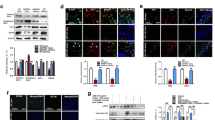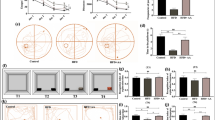Abstract
A high fat diet (HFD) is considered to be a risk factor for the development of dementia because it increases oxidative stress in the brain; thus, diets rich in antioxidants, such as polyphenols, may protect against oxidative damage. In this study, we explored the antioxidant activity and neural protective function of millet on high fat diet-induced oxidative stress in rat brains. Our results suggested that the intake of millet could alleviate oxidative stress in the hippocampus and downregulate the expression of the Alzheimer’s disease (AD)-related genes amyloid precursor protein (App), tau, and γ-secretase. Furthermore, we extracted millet polyphenols and verified whether they play important roles during this process. The results showed that millet polyphenols significantly prevented H2O2-induced cell death of SH-SY5Y cells and decreased oxidative stress levels in cells. In addition, the expression levels of pro-inflammatory factors and AD-related genes were also downregulated by treatment with millet polyphenols. The above results indicated that millet and millet polyphenols could exert neural protective effects under high fat diet-induced oxidative stress by upregulating the expression of antioxidant enzymes and downregulating the expression of AD-related genes.



Similar content being viewed by others
Abbreviations
- AD:
-
Alzheimer’s disease
- ABTS:
-
2,2′-Azinobis(3-ethylbenzothiazoline-6-sulfonic acid) diammonium salt
- App:
-
Amyloid precursor protein
- ATRA:
-
All-trans-retinoic acid
- Bace1:
-
Beta-site App-cleaving enzyme I
- BC:
-
Basal diet control
- CAT:
-
Catalase
- DMEM:
-
Dulbecco’s minimum essential medium
- DPPH:
-
2,2-diphenyl-1-picrylhydrazyl radical
- GSH:
-
Glutathione
- HFD:
-
High fat diet
- MDA:
-
Malondialdehyde
- MP:
-
Millet polyphenols
- MTT:
-
3-(4,5-Dimethylthiazol-2-yl)-2,5 -diphenyltetrazolium bromide
- NF-κB:
-
nuclear factor kappa-B
- PS1:
-
Presenilin-1
- SOD:
-
Superoxide dismutase
References
Freeman LR, Haley-Zitlin V, Rosenberger DS, Granholm AC (2014) Damaging effects of a high-fat diet to the brain and cognition: a review of proposed mechanisms. Nutr Neurosci 17(6):241–251
Chung A, Gurtu S, Chakravarthi S, Moorthy M, Palanisamy UD (2018) Geraniin protects high-fat diet-induced oxidative stress in Sprague Dawley rats. Front Nutr 5:17. https://doi.org/10.3389/fnut.2018.00017
Kumar KH, Khanum F (2013) Hydroalcoholic extract of Cyperus rotundus ameliorates H2O2-induced human neuronal cell damage via its anti-oxidative and anti-apoptotic machinery. Cell Mol Neurobiol 33(1):5–17
Busquets O, Ettcheto M, Pallàs M, Beas-Zarate C, Verdaguer E, Auladell C, Folch J, Camins A (2017) Long-term exposition to a high fat diet favors the appearance of β-amyloid depositions in the brain of C57BL_6J mice. A potential model of sporadic Alzheimer’s disease. Mech Ageing Dev 162:38–45
Yeo ETY, Wong KWL, Seea ML, Wong KY, Gan SY, Chanb EWL (2018) Piper sarmentosum Roxb. confers neuroprotection on beta-amyloid (Aβ)-induced microglia-mediated neuroinflammation and attenuates tau hyperphosphorylation in SH-SY5Y cells. J Ethnopharmacol 217. https://doi.org/10.1016/j.jep.2018.02.025
Nagpure BV, Bian J-S (2014) Hydrogen sulfide inhibits A2A adenosine receptor agonist induced β-amyloid production in SH-SY5Y neuroblastoma cells via a cAMP dependent pathway. PLoS One 9:1–12
González-Reyes RE, Ariza-Salamanca D, Nava-Mesa MO, Mora-Muñoz L, Vargas-Sánchez K (2017) Involvement of astrocytes in Alzheimer’s disease from a neuroinflammatory and oxidative stress perspective. Front Mol Neurosci 10(427):1–20
Sharma S, Sharma N, Handa S, Pathania S (2017) Evaluation of health potential of nutritionally enriched Kodo millet (Eleusine coracana) grown in Himachal Pradesh, India. Food Chem 214:162–168
Kumari D, Madhujith T, Chandrasekara A (2017) Comparison of phenolic content and antioxidant activities of millet varieties grown in different locations in Sri Lanka. Food Sci Nutr 5:474–485
Filosa S, Di Meo F, Crispi S (2018) Polyphenols-gut microbiota interplay and brain neuromodulation. Neural Regen Res 13(12):2055–2059
Figueira I, Garcia G, Pimpao RC, Terrasso AP, Costa I, Almeida AF, Tavares L, Pais TF, Pinto P, Ventura MR, Filipe A, McDougall GJ, Stewart D, Kim KS, Palmela I, Brites D, Brito MA, Brito C, Santos CN (2017) Polyphenols journey through blood-brain barrier towards neuronal protection. Sci Rep-UK 7(1):11456. https://doi.org/10.1038/s41598-017-11512-6
Edwards CA, Havlik J, Cong W, Mullen W, Preston T, Morrison DJ, Combet E (2017) Polyphenols and health: interactions between fibre, plant polyphenols and the gut microbiota. Nutr Bull 42:356–360
Dewanto V, Wu X, LIU RX (2002) Processed sweet corn has higher antioxidant activity. J Agric Food Chem 50:4959–4964
Bamdad F, Wu J, Chen L (2011) Effects of enzymatic hydrolysis on molecular structure and antioxidant activity of barley hordein. J Cereal Sci 54(1):20–28
Shang H, Zhang H, Guo Y, Wu H, Zhang N (2019) Effects of inulin supplementation in laying hens diet on the antioxidant capacity of refrigerated stored eggs. Int J Biol Macromol. https://doi.org/10.1016/j.ijbiomac.2019.10.234
Liu Y, Huang G (2018) The derivatization and antioxidant activities of yeast mannan. Int J Biol Macromol 107:755–761
Fukuyama K, Kakio S, Nakazawa Y, Kobata K, Funakoshi-Tago M, Suzuki T, Tamura H (2018) Roasted coffee reduces β-amyloid production by increasing proteasomal β-secretase degradation in human neuroblastoma SH-SY5Y cells. Mol Nutr Food Res 1800238:1–9. https://doi.org/10.1002/mnfr.201800238
Sarma SM, Khare P, Jagtap S, Singh DP, Baboota RK, Podili K, Boparai RK, Kaur J, Bhutani KK, Bishnoi M, Kondepudi KK (2017) Kodo millet whole grain and bran supplementation prevents high-fat diet induced derangements in a lipid profile, inflammatory status and gut bacteria in mice. Food Funct 8(3):1174–1183
Cheignon C, Tomas M, Bonnefont-Rousselot D, Faller P, Hureau C, Collin F (2018) Oxidative stress and the amyloid beta peptide in Alzheimer's disease. Redox Biol 14:450–464
Chakravarthy B, Gaudet C, Menard M, Atkinson T, Brown L, Laferla FM, Armato U, Whitfield J (2010) Amyloid-beta peptides stimulate the expression of the p75(NTR) neurotrophin receptor in SHSY5Y human neuroblastoma cells and AD transgenic mice. J Alzheimers Dis 19(3):915–925
Shen Y, Zhang H, Cheng L, Wang L, Qian H, Qi X (2016) In vitro and in vivo antioxidant activity of polyphenols extracted from black highland barley. Food Chem 194:1003–1012
Wang D, Ho L, Faith J, Ono K, Janle EM, Lachcik PJ, Cooper BR, Jannasch AH, D'Arcy BR, Williams BA, Ferruzzi MG, Levine S, Zhao W, Dubner L, Pasinetti GM (2015) Role of intestinal microbiota in the generation of polyphenol-derived phenolic acid mediated attenuation of Alzheimer's disease beta-amyloid oligomerization. Mol Nutr Food Res 59(6):1025–1040
Acknowledgements
This work was supported by the National Key Research and Development Program of China [Grant number: 2017YFD0401202] and the National Natural Science Foundation of China [Grant number: 31901609].
Author information
Authors and Affiliations
Corresponding author
Ethics declarations
Conflict of Interest
We do not have conflicts of interest to declare.
Additional information
Publisher’s Note
Springer Nature remains neutral with regard to jurisdictional claims in published maps and institutional affiliations.
Sen Li and Furong Xian are Co-first authors
Rights and permissions
About this article
Cite this article
Li, S., Xian, F., Guan, X. et al. Neural Protective Effects of Millet and Millet Polyphenols on High-Fat Diet-Induced Oxidative Stress in the Brain. Plant Foods Hum Nutr 75, 208–214 (2020). https://doi.org/10.1007/s11130-020-00802-6
Published:
Issue Date:
DOI: https://doi.org/10.1007/s11130-020-00802-6




